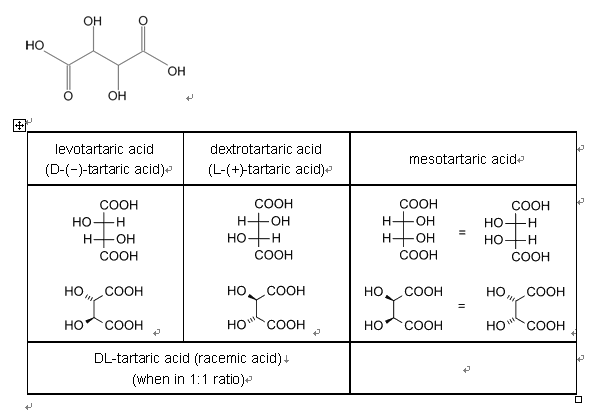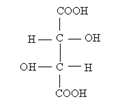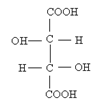CAS No: 526-83-0 tartaric
acid
87-69-4 dextrotartaric acid L-(R, R)-(+)-tartaric acid
natural isomer
147-71-7 levotartaric acid D-(S, S)-(?)-tartaric acid
unnatural isomer
147-73-9 mesotartaric acid (2R, 3S)-tartaric acid
133-37-9 racemic acid DL-(S, S/R, R)-(¡À)-tartaric acid
Chemical Name: 2, 3-dihydroxybutanedioic acid
Molecular Formula: C4H6O6
Molecular Weight: 150.09
Chemical Structural:

levotartaric acid (D-(?)-tartaric
acid) dextrotartaric acid (L-(+)-tartaric acid) mesotartaric
acid
DL-tartaric acid (racemic acid)
(when in 1:1 ratio)
Naturally occurring tartaric
acid is chiral, the form is L-(+)-tartaric acid or dextrotartaric
acid. It occurs in many plants, particularly grapes,
bananas and tamarinds. The enantiomeric form is D-(?)-tartaric
acid or levotartaric acid, and the achiral form is mesotartaric
acid. DL-tartaric acid is a 1:1 mixture of the levo
and dextro forms, it is distinct from mesotartaric acid
and was called racemic acid.
Tartaric acid is a white crystalline organic acid. It
is one of the main acids found in wine. It is added
to other foods to give a sour taste, and is used as
an antioxidant. Tartrates, such as, cream of tartar
(potassium bitartrate), Rochelle salt (potassium sodium
tartrate) and tartar emetic (antimony potassium tartrate)
are used to enhance flavours in foods, confectionery
and beverages.
Note: the dextro and levo prefixes are not related to
the D/L configuration (which is derived from the reference
D- or L-glyceraldehyde), but to the orientation of the
optical rotation, (+) = dextrorotatory, (?) = levorotatory.
L-(+)-Tartaric acid
Chemical Name: (2R, 3R)-2,
3-dihydroxy butane-1.4-dioic acid
Structural Formula:

Character: Colorless or white crystalline, odorless,
acdic taste.
Uses: widely used as acidulant in beverage and other
foods, such as soft drinks, wine, candy, bread and some
colloidal sweetmeats.
D-(-)-Tartaric acid
Chemical Name: (2S, 3S)-2,
3-dihydroxy butane-1.4-dioic acid
Structural Formula:

Character: Colorless or white crystalline, odorless,
acdic taste.
Uses: It is mainly used as sour agent.
DL-Tartaric Acid
Structural Formula:

Character: Colorless or white crystalline, odorless,
acdic taste.
Uses: as beer vesicant and food sourness agent and flavoring,
its sourness is the citric acid 1.3 times, and especially
is suitable to do the sourness agent of the grape juice.
Standards: FCC IV / BP2005
/ USP24
Packing: 25kg / bag
Storage: Keep container tightly closed. Keep in a cool,
dry, well-ventilated place. |
